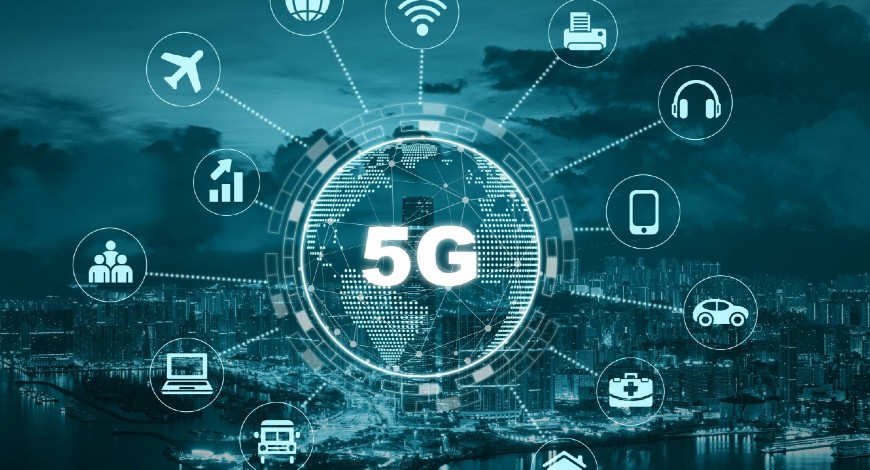5G
5G services market size expected to expand at CAGR of 52.0%

The global 5G services market size was valued at USD 47.3 billion in 2021 and is expected to expand at a compound annual growth rate (CAGR) of 52.0% from 2022 to 2030. 5G wireless mobile services enable a fully mobile and connected environment by delivering a wide range of use cases and business models to consumers. Moreover, faster data speeds and extremely low latency offered by the 5G technology would enhance the user experience while using 5G services for several use cases, such as Virtual Reality (VR) and Augmented Reality (AR) gaming, seamless video calling, and Ultra-High Definition (UHD) videos, among others. The growing demand for high-speed data connectivity for unified Internet of Things (IoT) applications, such as smart home energy management, is estimated to propel the adoption of these services over the forecast period.
Moreover, the rising focus on building partnerships by 5G system integration providers with telecom operators is estimated to augment the adoption of these services. Many industry verticals are focusing on technological transformations to improve their overall productivity and operational efficiency as part of the efforts to sustain in a highly competitive environment. The 5G wireless technology holds the potential to help in realizing remarkable transformations across all these verticals through reductions in overall costs and enhancement in productivity. The continued emphasis on improving energy monitoring and management as well as gaining better control of the energy generation and distribution network is also expected to boost the market growth over the forecast period.
When it comes to healthcare, some of the largest economies, such as the U.S. and China, are expected to continue investing heavily in the provision of healthcare facilities. For instance, the National Health Expenditure Accounts (NHEA) of the U.S. expects the overall healthcare spending in the country to reach more than USD 6.2 trillion by 2030 exhibiting a CAGR of nearly 7% from 2022 to 2030. Modern healthcare would particularly focus on administering technology-driven treatments to the patients, thereby driving the market growth over the forecast period. Apart from energy & utilities and healthcare, transportation & logistics is another industry vertical that can offer potential opportunities to this market.
For instance, the concept of Vehicle-to-anything (V2X) communication has paved the way for connected vehicles and autonomous driving. 5G services would be playing a crucial role in providing seamless Vehicle-to-Infrastructure (V2I) communication and Vehicle-to-Vehicle (V2V) communication to reduce the chances of accidents on roads. The growing emphasis on ensuring a safe and enhanced driving experience with connected vehicles is expected to drive market growth over the forecast period. The next generation 5G technologies are increasingly being used in public transportation applications.
These technologies can provide broadband access for public transportation systems, such as buses and high-speed trains, to provide high-speed internet in transit for entertainment, information, and interaction with smart mobility components. This, in turn, is expected to fuel the market growth. Moreover, the strong emphasis on providing reliable and robust communication during natural disasters, such as floods, hurricanes, and earthquakes, is further estimated to spur the adoption of 5G services. However, the governments are quoting significantly high prices for service providers for procuring the 5G spectrum. Service providers would have no other option but to pass on these costs to the end-users.
Thus, the high spectrum prices and the subsequent hike in 5G service subscription prices are expected to hinder the market growth to some extent. As the market is in the introduction phase, several key service providers across the globe are investing in deploying modern network infrastructure to tap the maximum subscriber base in their region. However, the outbreak of the COVID-19 has put the deployment of several 5G cores and base station infrastructures on hold across the globe. In addition, the spectrum auction for 5G services has been postponed by several federal governments across key countries, such as Spain, the U.S., and France, which will hinder the market growth.
Communication Type Insights
The enhanced Mobile Broadband (eMBB) segment dominated the market with a share of more than 42% in 2021 and is expected to grow considerably over the forecast period. The high share is attributed to the preliminary focus by 5G network operators on delivering enhanced broadband capabilities for applications, such as high-speed cloud-based gaming, AR/VR, UHD video, and uninterrupted video calls. The initial phase of the rollout is expected to focus on a 5G wireless non-standalone deployment model. eMBB provides extremely high data speeds for residential and commercial use.
Thus, eMBB is expected to cater to several use cases, such as in-vehicle infotainment, 4K video access, and virtual meeting, thereby driving the segment growth. The massive Machine-Type Communications (mMTC) segment is expected to witness the fastest CAGR from 2022 to 2030. Massive machine-type communications envisage catering to the growing need for a developed digital ecosystem. mMTC focuses on providing services for high connection density applications, such as smart buildings and smart cities. The growing need to ensure uninterrupted connectivity for all the IoT devices deployed in a network is anticipated to contribute to the growth of the mMTC segment over the forecast period.
CT Bureau















You must be logged in to post a comment Login